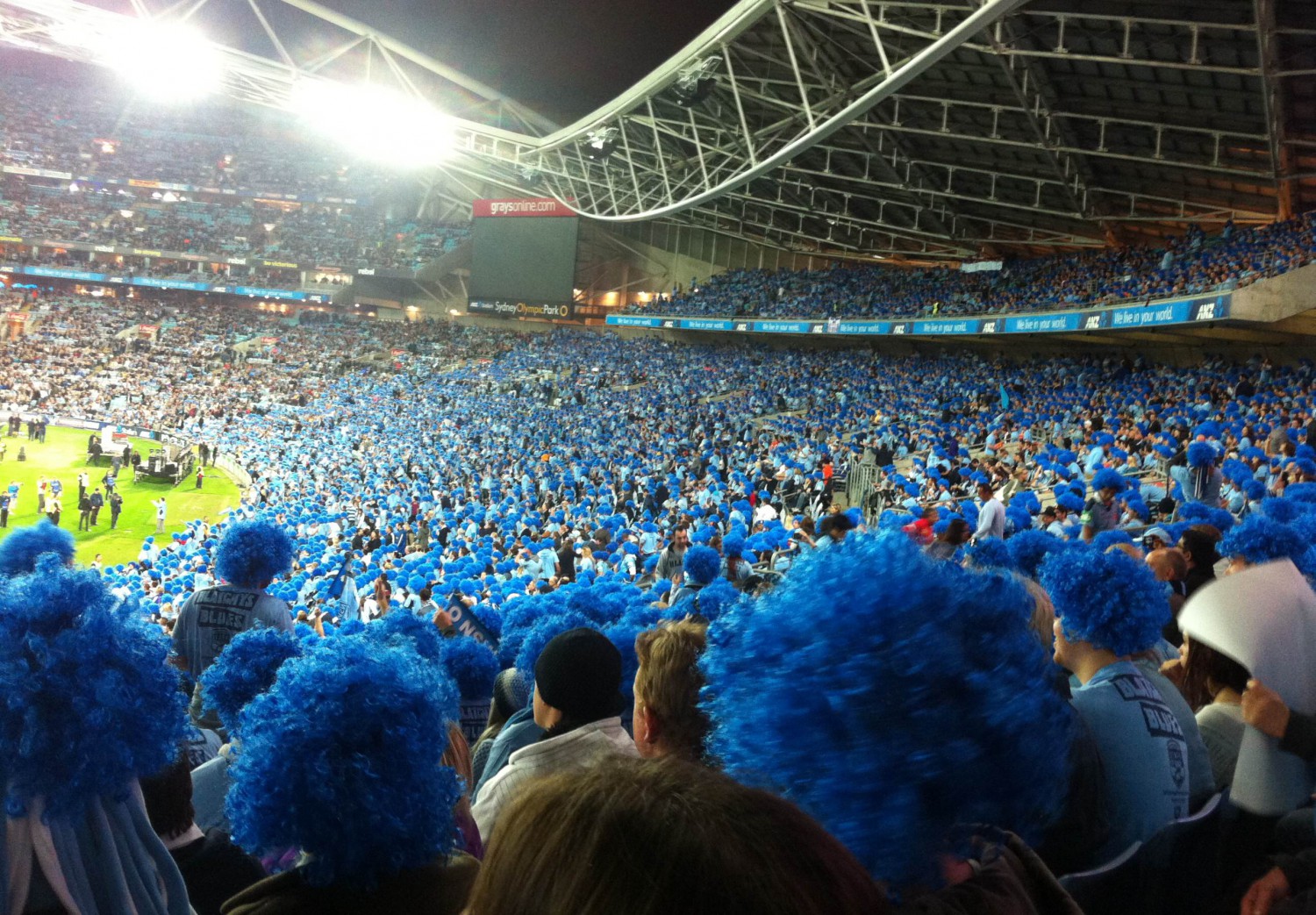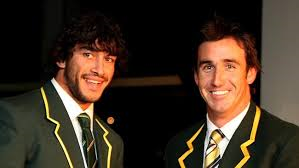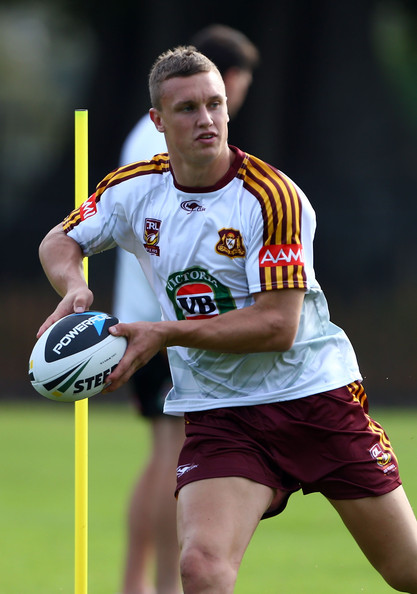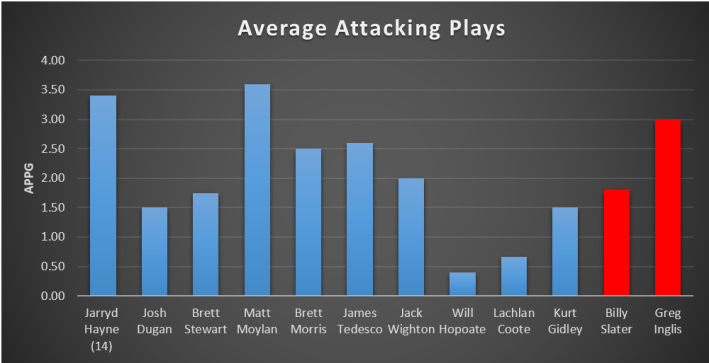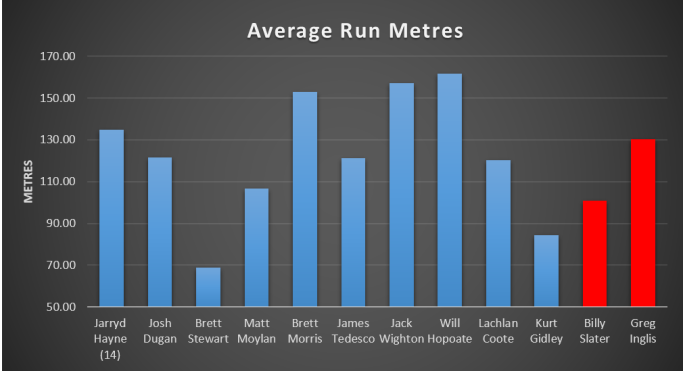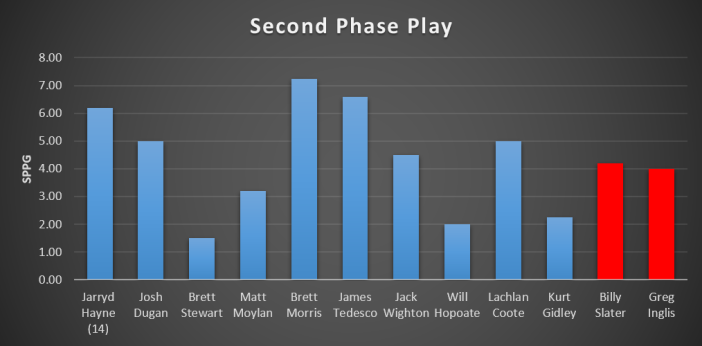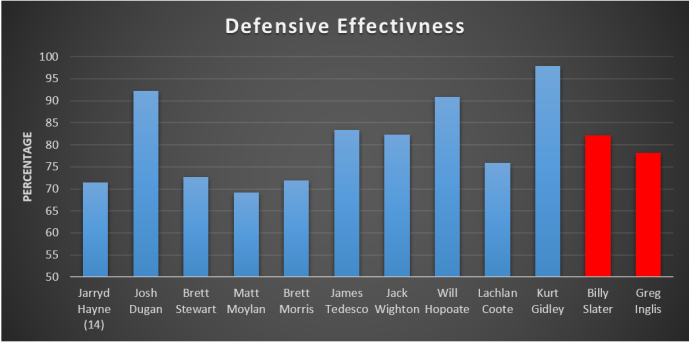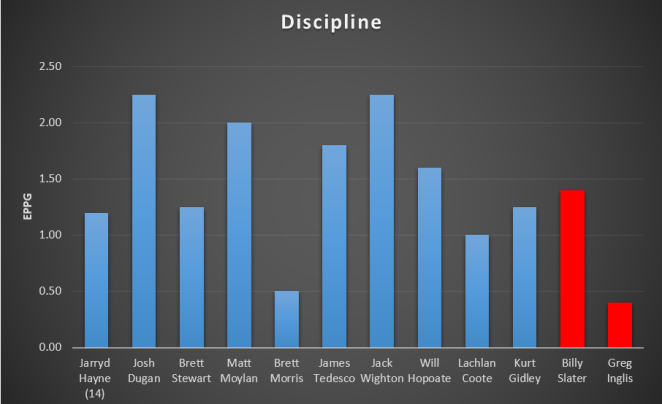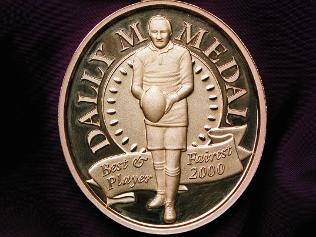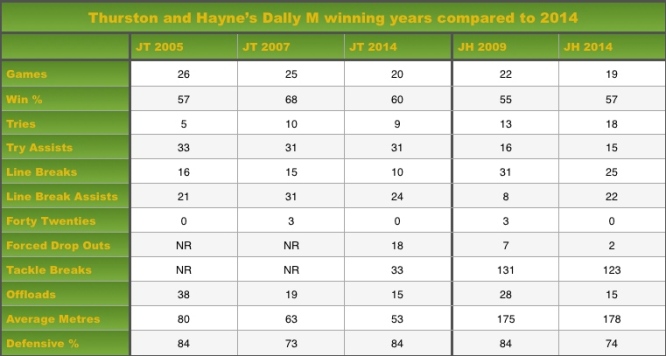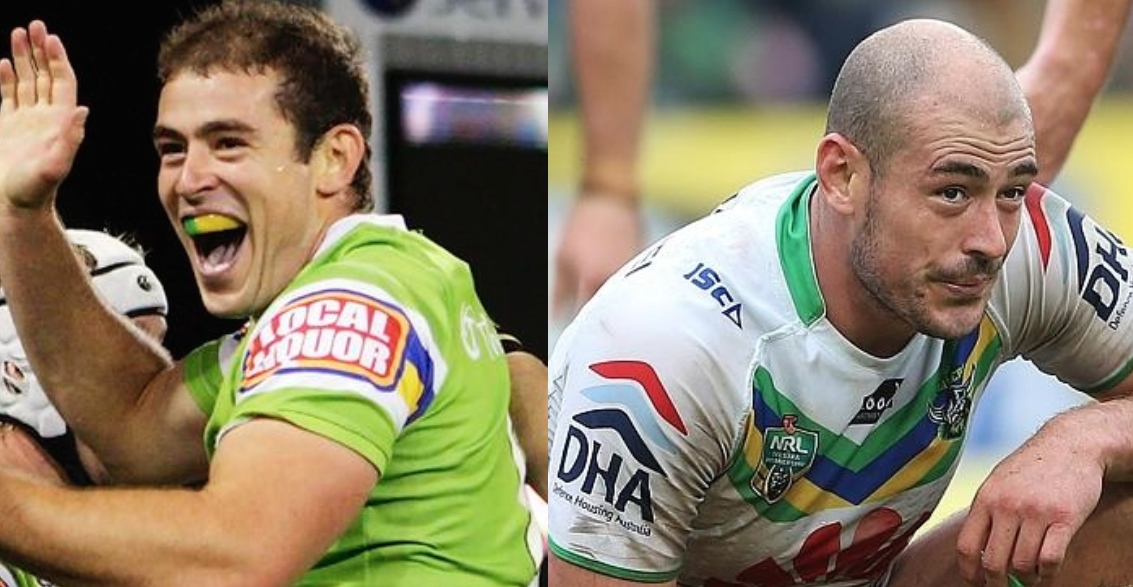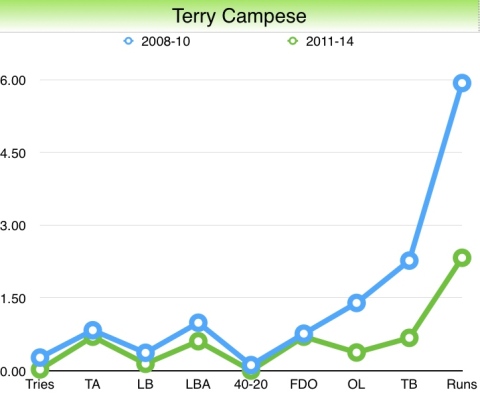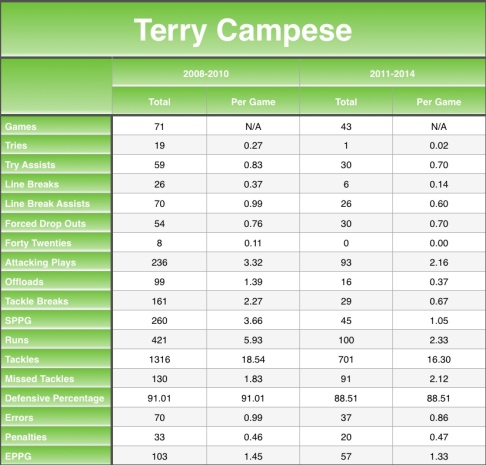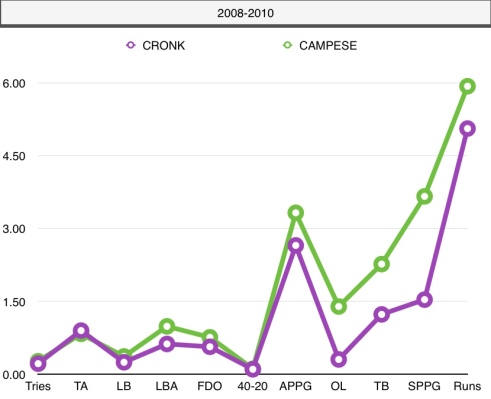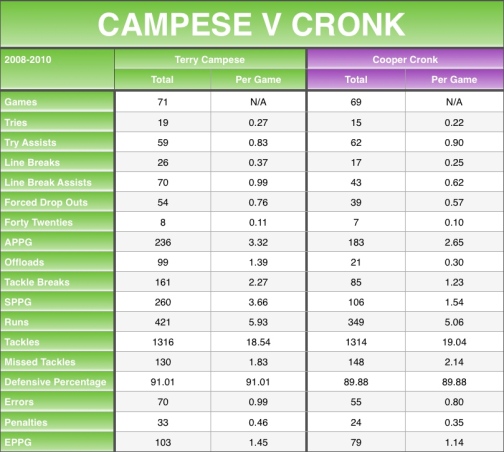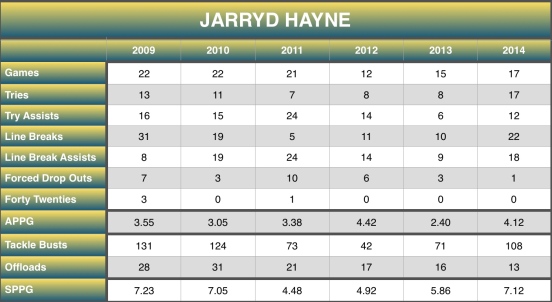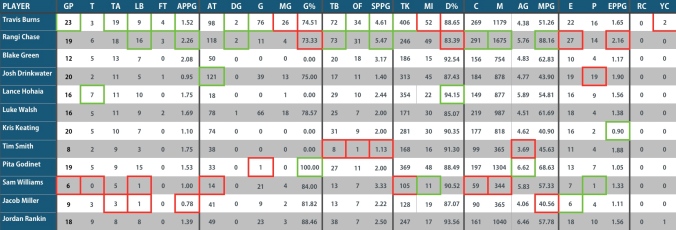On Tuesday Fox Sports released an article attempting to compare Andrew Johns and Johnathan Thurston, by the numbers. The article only compared games, points, awards, titles, etc. In my opinion they could have done a better job. This article will attempt to go a little further.
Comparing these to great Halfbacks is no easy task, as I am not a statistician and do not have access to NRL stats databases. The stats I have managed to find on Andrew Johns are incomplete. The reason for this is the NRL did not start collecting detailed statistics (Line Breaks, Offloads, etc.) until 1998 and in the seasons that followed they increased in detail (Try Assists, Line Break Assists, etc.). Another issue with this comparison is the different stats providers, for example: all the stats I have for Andrew Johns were recorded by the NRL’s old stats provider Sports Data and the stats I have on Johnathan Thurston were recorded by Fox Sports. The reason I have not used Sports Data stats for JT is they are only available up till 2007. This is an issue because different stats providers have been shown to have differences in their records, for example: for the 2007 season Sports Data recorded 31 try assists and 19 offloads for Johnathan Thurston, while Fox Sports recorded 30 and 16 respectively. The issues mentioned above illuminates that this is a flawed attempt to compare the incomparable.
 [Game statistics sourced from www.rugbyleagueproject.org]
[Game statistics sourced from www.rugbyleagueproject.org]
They have each played 249 first grade games; Joey won 61.8% of games, including 2 premierships for Newcastle, while JT has won 53.8% of games across 2 clubs including 1 premiership. JT has taken part in 8 winning series for Queensland; winning 63.3% of games compared to Joey’s 5 series wins for NSW at 56.5%. As a side note: 16 of Joey’s 23 Origin appearances were at Halfback, while the other 7 were played at Hooker or off the bench. Joey won 87% of games for Australia, with 2 World Cup victories; while JT has won 93.5% of games for Australia with 1 World Cup victory.
 [Award statistics sourced from www.rugbyleagueproject.org]
[Award statistics sourced from www.rugbyleagueproject.org]
They are equal on top with 3 Dally M Medals a piece, in addition they have taken out 2 Golden Boots. JT has the edge on Dally M positional awards with 6 (3 at Halfback and 3 at 5-8) compared to Joeys 4 at Halfback. Joey claimed a Clive Churchill Medal in 2001, the only major award JT is without.
To this point we have covered all the basic stats that everyone already knows; we will now delve into the nitty gritty, starting with their attacking game.
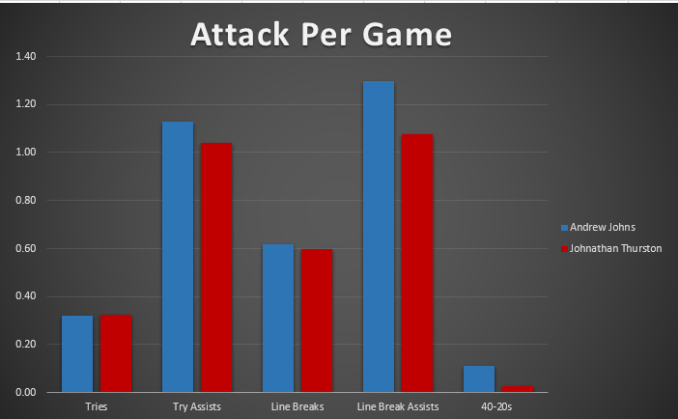 [Andrew Johns Stats sourced from Sports Data’s NRLstats.com; Johnathan Thurston Stats Sourced from Fox Sports.]
[Andrew Johns Stats sourced from Sports Data’s NRLstats.com; Johnathan Thurston Stats Sourced from Fox Sports.]
As discussed above the stats I found on Andrew Johns were incomplete, which makes this comparison unfair for both players. We of course have a complete record of Joey’s tries; scoring 80 from his 249 games compared to JT who has crossed the line 81 times from 249 games, a per game strike rate of 0.32 and 0.33 respectively. I only have try assist stats for 147 of Joey’s appearances, where he managed 166 at a strike rate of 1.13 per game. JT has assisted in 259 tries at a strike rate of 1.04 per game. Joey broke the line 107 times in the 173 games that were recorded, a strike rate of 0.62 per game; compared to 149 line breaks made by JT at 0.60 per game. Line Break Assists is the smallest sample I have on Johns as they were only recorded for 81 of his 249 appearances. In that period Joey assisted in 105 line breaks at a rate of 1.30 per game. JT has assisted 268 line breaks at a rate of 1.08 per game. Joey dominated when it came to forty twenties; kicking 16 from the 147 games recorded at 0.11 per game; compared to JT who has only managed 6 from 243 games (couldn’t find stats on a few finals games) at 0.02 per game.
Joey produced 338 offloads in the 173 games that they were recorded at 1.95 per game; compared to JT who has to date produced 232 offloads at 0.93 per game. Joey averaged 60.78 metres per game in the 147 that were recorded; compared to JT who has averaged 63.50 across his career. It’s fair to say that if we had complete stats on Joey’s career his per game averages would slide back towards JT’s numbers; however, how much is unclear as we are missing stats on years where he won a Premiership, a Dally M and a Halfback of the year award.
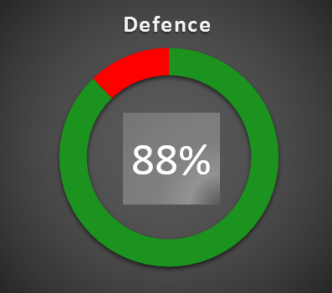
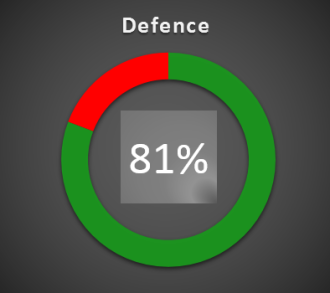 [Andrew Johns stats sourced from Sports Data from 173 of 249 games, Johnathan Thurston’s stats sourced from Fox Sports across 249 games = % (total tackles/total attempts displayed as percentage)]
[Andrew Johns stats sourced from Sports Data from 173 of 249 games, Johnathan Thurston’s stats sourced from Fox Sports across 249 games = % (total tackles/total attempts displayed as percentage)]
I found Defensive stats for 173 of Joey’s games where he averaged 14.61 tackles per game, missing 2.03 per game. JT‘s has averaged 14.70 tackles per game across his career averaging 3.50 misses. Fox Sports has JT’s effectiveness in defence at 75%; this must include ineffective tackles, which I could not find figures for. To be fair to JT I used the same simple formula that was used for Joey (total tackles made divided by total tackles attempted times 100). Using this simple method Joey made 88% of all tackles attempted compared to JT who has been 81% successful.
When it comes to errors and penalties the stats I found indicate that JT is slightly less disciplined. In the 173 games that errors were recorded, Joey made 213 at 1.23 per game, compared to JT who has made 396 errors at 1.59 per game. Penalties were only recorded for 81 of Joey’s games where he conceded 44 at 0.54 per game, compare to JT who has conceded 156 at 0.63 per game. In addition JT has also been sin binned on 4 occasions. I am not sure if Joey has ever been sent to the bin.
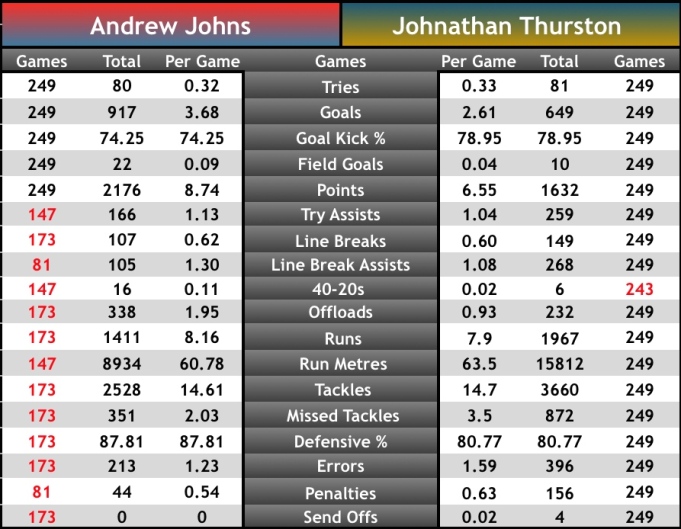 [Andrew Johns stats sourced from Sports Data; Johnathan Thurston’s stats sourced from Fox Sports. Highlighted red text means the data is incomplete. * Numbers have been derived from per game averages times the total games, therefore the figure will not be totally accurate.]
[Andrew Johns stats sourced from Sports Data; Johnathan Thurston’s stats sourced from Fox Sports. Highlighted red text means the data is incomplete. * Numbers have been derived from per game averages times the total games, therefore the figure will not be totally accurate.]
Numbers won’t settle the debate as people either love or hate these two players. From my perspective it has been fantastic watching these two magicians dominate over the years.
